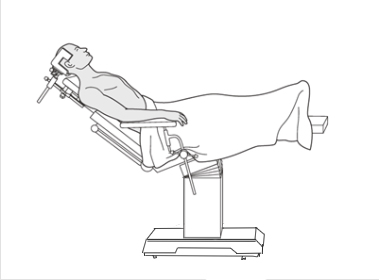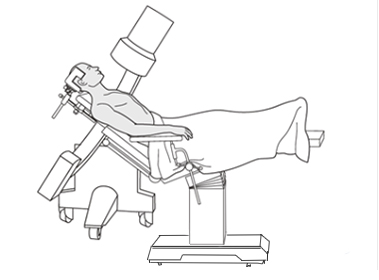

Introduction
The beach chair surgical position, also known as the semi-sitting or semi-Fowler position, is a commonly utilized patient positioning technique in various surgical disciplines, notably in orthopedic, neurosurgical, and otolaryngological procedures. This position involves seating the patient in a reclined posture, resembling a surgical beach chair , to optimize surgical access and patient safety.
What is the Beach Chair Position?
In the beach chair position, the patient is placed in a semi-upright posture with the torso elevated at an angle between 30° to 60°, hips and knees slightly flexed, and the head secured in a neutral alignment. This configuration facilitates gravitational drainage, enhances surgical exposure, and improves airway management during anesthesia.

Clinical Applications
The beach chair position is predominantly employed in:
● Shoulder surgeries: Arthroscopic and open procedures such as rotator cuff repairs, shoulder arthroplasty, and labral repairs .
● Clavicle and proximal humerus fractures: Facilitates anterior and lateral access to the shoulder joint .
● Neurosurgical procedures: Posterior fossa surgeries and certain cervical spine operations.
● ENT surgeries: Procedures involving the cranial base and facial structures.
Advantages
● Enhanced Surgical Access: Provides excellent visualization of the anterior and superior aspects of the shoulder joint, aiding in precise surgical interventions .
● Improved Airway Management: The semi-upright position facilitates easier airway access for anesthesiologists, reducing the risk of airway complications .
● Reduced Brachial Plexus Strain: Compared to the lateral decubitus position, the beach chair position minimizes traction on the brachial plexus, decreasing the risk of nerve injuries .
● Gravity-Assisted Drainage: Promotes venous drainage from the surgical site, potentially reducing intraoperative bleeding.
● Ease of Conversion: Allows for straightforward conversion from arthroscopic to open procedures if necessary .

Safety Considerations and Potential Complications
While the beach chair position offers numerous benefits, it is not without risks. Key considerations include:
1. Cerebral Hypoperfusion
Elevating the patient's head can lead to decreased cerebral perfusion pressure, increasing the risk of cerebral ischemia. Anesthesiologists must monitor mean arterial pressure (MAP) closely, ensuring it remains within safe limits relative to the brain's position .
2. Air Embolism
The semi-sitting position may predispose patients to venous air embolism, particularly during neurosurgical procedures. Employing precordial Doppler monitoring can aid in early detection .
3. Nerve Injuries
Improper positioning can result in nerve compressions, including brachial plexus, ulnar, and peroneal nerves. Adequate padding and limb support are essential to mitigate this risk .
4. Pressure Ulcers
Prolonged surgeries increase the risk of pressure sores, especially at the occiput, sacrum, and heels. Regular assessment and repositioning, along with appropriate cushioning, are vital preventive measures.
Best Practices for Patient Safety
To optimize patient outcomes and minimize complications:
● Head and Neck Alignment: Maintain a neutral position to prevent cervical spine strain .
● Blood Pressure Monitoring:Measure MAP at the level of the brain to ensure adequate cerebral perfusion .
● Adequate Padding: Use cushioning at pressure points, including elbows, heels, and sacrum, to prevent nerve injuries and pressure ulcers
● Secure Positioning: Employ safety straps and supports to maintain patient stability throughout the procedure.
● Team Coordination: Ensure clear communication among surgical, anesthesia, and nursing teams during positioning and throughout the surgery.
Conclusion
The beach chair surgical position is a valuable technique that enhances surgical access and patient safety across various procedures. Healthcare professionals can effectively utilize this position to improve surgical outcomes by understanding its applications, benefits, and potential risks.
Related Resources
References
1.Meta F, Ulrich MN, Simon KN, et al. Basics of Shoulder Arthroscopy Part I: Beach-Chair Patient Positioning and Operating Room Setup. Arthrosc Tech. 2024;13(10):103082. doi:10.1016/j.eats.2024.103082. PMC11519874
2.https://surgeryreference.aofoundation.org/orthopedic-trauma/adult-trauma/humeral-shaft/preparation/beach-chair-position
3.https://www.hillrom.com/en/knowledge/article/safe-patient-handling-surgical-tables/
4.https://aneskey.com/complications-of-the-beach-chair-position/